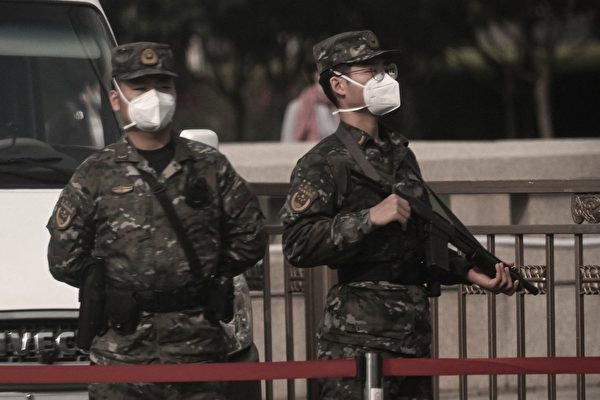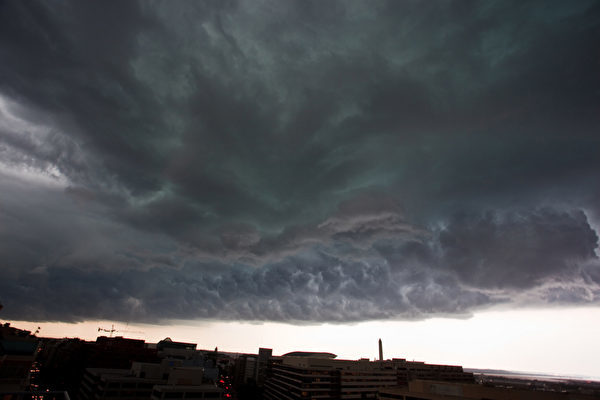Caption: On October 13, 2022, ahead of the 20th National Congress of the Chinese Communist Party, security personnel were stationed along the road leading to Tiananmen Square. (NOEL CELIS/AFP via Getty Images)
[People News] Overseas independent media influencer Li Muyang has just exclusively revealed that Xi Jinping suffered another stroke during the Chinese New Year period, following previous reports of a stroke during the 20th CCP Third Plenary Session in July last year. He reportedly received treatment at either Peking Union Medical College Hospital or the 301 Military Hospital in Beijing and has since stabilized.
Videos from February 5 and 6 showing Xi meeting with visiting leaders from Kyrgyzstan, Pakistan, Brunei, and Thailand suggest that he still appears lacking in energy. When compared to footage from his January 24, 2023, meeting with Uzbek President Mirziyoyev, the difference is even more pronounced—Xi not only looks noticeably older but also exhibits an even greater lack of vitality, despite the Chinese state media’s deliberate efforts to enhance his appearance.
Some may question how Xi could recover in less than a week if he had indeed suffered another stroke. The first point to consider is that, following his previous stroke, CCP health experts have likely been monitoring his condition around the clock. Any subtle symptoms would have been detected immediately, leading to swift medical intervention. This suggests that the recent incident was caught early and treated quickly.
Secondly, Peking Union Medical College Hospital has long developed effective treatments for strokes. On August 21, 2010, its website published an article titled "PUMCH Achieves Good Emergency Treatment Results for Acute Stroke Patients," highlighting how its neurology department, in collaboration with other medical units, adopted multiple treatment methods to target the critical time window for acute ischemic stroke, achieving significant success. This medical breakthrough earned a third-class award in the hospital’s 2009 medical achievements recognition.
The article also stated that effective clinical treatments for ischemic stroke include antiplatelet medication, stroke unit care, and thrombolytic therapy, with thrombolysis being the most immediately effective. Associate Professor Peng Bin from the Neurology Department explained that thrombolysis is highly effective and cost-efficient. Many patients who experienced hemiplegia (paralysis on one side of the body) regained motor and neurological functions in a short time after receiving timely thrombolytic treatment.
That article was published 15 years ago. Since then, what further advancements has PUMCH made in stroke treatment?
On October 24, 2024, the Peking Union Medical College Hospital (PUMCH) website published a major news report titled "The 'Small' Brain, Big Impact—PUMCH Experts Use Brain Organoids to Simulate Stroke, Elucidate Pathogenesis, and Prove the Efficacy of Traditional Chinese Medicine."
The report states that Professor Leng Ling from the Clinical Medicine Research Institute at Peking Union Medical College Hospital (PUMCH) led a team that constructed an ischemic stroke model using brain organoids to investigate its pathogenesis. Through comparative studies with animal experiments, they discovered that a traditional Chinese medicine formula might be effective in treating ischemic stroke. The findings were published in the Chinese Academy of Sciences' top-tier journal Bioactive Materials (Impact Factor: 18). This research was supported by the National High-Level Hospital Clinical Research Special Fund and the Chinese Academy of Medical Sciences' Leading Medical and Health Science and Technology Innovation Project.
There is also a strong possibility that after the Party leader's health issue last year, the CCP significantly increased funding for medical research on stroke treatment, hoping to find a definitive cure. Some indications support this theory, and Xi's quick recovery and reappearance after his stroke may be linked to these efforts.
For instance, on August 24, 2023, the 2024 Human Brain Forum was held in Beijing. The forum was hosted by the Chinese Society of Anatomy and organized by the National Human Brain Tissue Resource Bank (affiliated with the Chinese Academy of Medical Sciences' Institute of Basic Medical Sciences and Neuroscience Center). It was co-organized by PUMCH, the China Human Brain Tissue Bank Collaboration Alliance, and the journal HUMAN BRAIN. The event attracted nearly 300 experts, scholars, doctors, and researchers from domestic and international medical schools, research institutes, healthcare institutions, and related industry R&D organizations.
The forum featured six sub-panels covering topics such as brain tissue banks, neuropsychiatric diseases, neurodegenerative diseases, neuroimaging, brain aging cohorts, and interdisciplinary innovation. A total of 24 scholars from China and abroad delivered reports.
Additionally, on November 16, 2023, PUMCH hosted the inaugural Union Heart-Brain Conference in Beijing. The CCP’s state media reported that this conference brought together experts from various fields, including cardiovascular science, neuroscience, imaging, and rheumatology, to discuss cross-disciplinary treatments for cardiovascular and cerebrovascular diseases.
On November 20, 2024, the establishment conference for the Dongcheng District Stroke Diagnosis and Treatment Quality Control and Improvement Center was held at PUMCH. Could this be a sign that the hospital is accumulating more case studies through increased patient treatment?
However, stroke remains a disease with high incidence, high recurrence rates, and high disability rates. There is currently no specific cure, and the likelihood of recurrence is extremely high. This means that having suffered at least two strokes, Xi Jinping is likely to continue experiencing recurring strokes in the future, with his condition only worsening over time.
Since Xi's first reported stroke in July 2023, there have been multiple unusual developments within the CCP leadership and the military, suggesting that Xi's grip on power has weakened. The CCP leadership may be planning for a successor, and the appearance of four suns over Beijing on the second day of the Lunar New Year may symbolize ongoing power struggles over who will take the top position.
2025 is Xi’s zodiac year (benmingnian). With this latest stroke, can Xi survive the challenges ahead? Has the CCP prepared contingency plans for the possibility of his sudden death? How will they manage potential social unrest? Perhaps the political landscape will shift even faster than people expect this year.
(First published by People News)











News magazine bootstrap themes!
I like this themes, fast loading and look profesional
Thank you Carlos!
You're welcome!
Please support me with give positive rating!
Yes Sure!